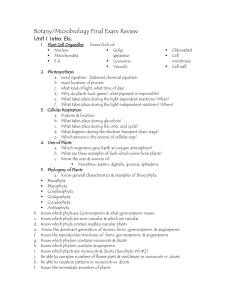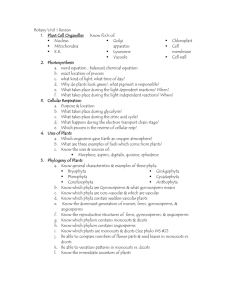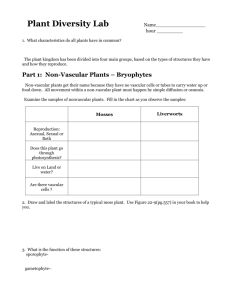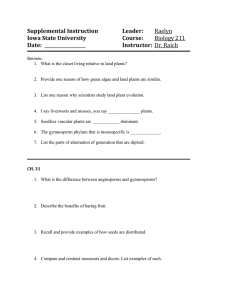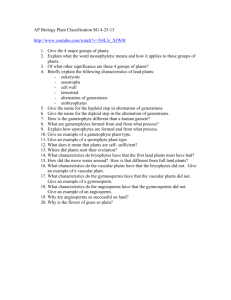Botany Final Exam Review ‘06 Uni1 – Introduction, etc.
advertisement
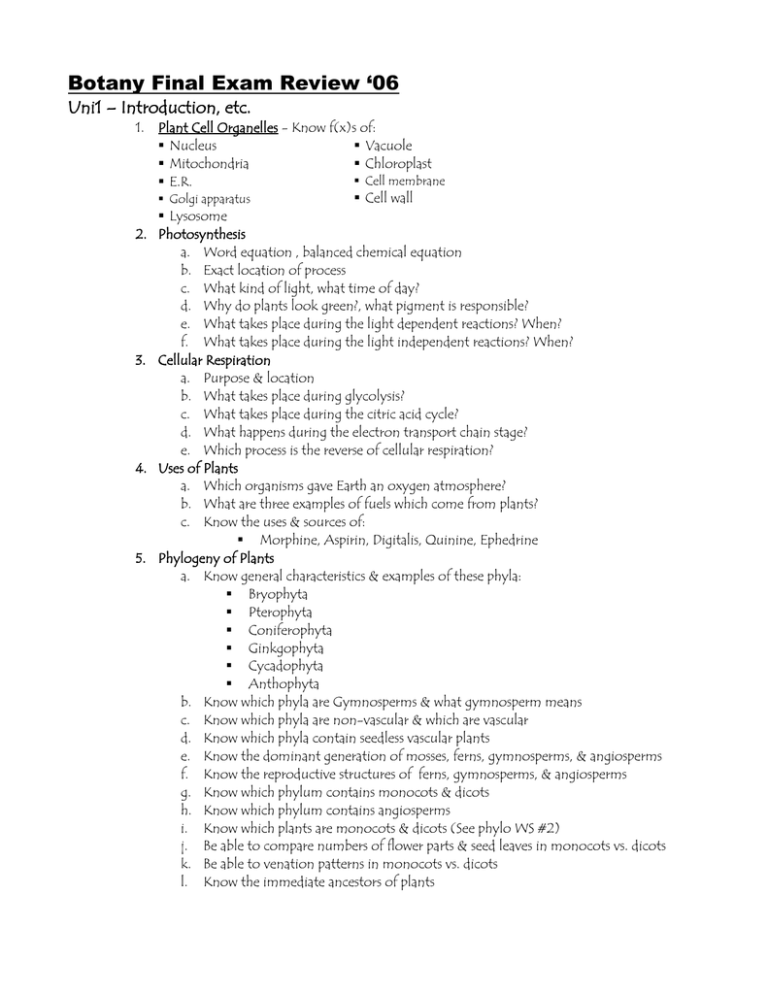
Botany Final Exam Review ‘06 Uni1 – Introduction, etc. 1. Plant Cell Organelles - Know f(x)s of: Nucleus Vacuole Mitochondria Chloroplast Cell membrane E.R. Cell wall Golgi apparatus Lysosome 2. Photosynthesis a. Word equation , balanced chemical equation b. Exact location of process c. What kind of light, what time of day? d. Why do plants look green?, what pigment is responsible? e. What takes place during the light dependent reactions? When? f. What takes place during the light independent reactions? When? 3. Cellular Respiration a. Purpose & location b. What takes place during glycolysis? c. What takes place during the citric acid cycle? d. What happens during the electron transport chain stage? e. Which process is the reverse of cellular respiration? 4. Uses of Plants a. Which organisms gave Earth an oxygen atmosphere? b. What are three examples of fuels which come from plants? c. Know the uses & sources of: Morphine, Aspirin, Digitalis, Quinine, Ephedrine 5. Phylogeny of Plants a. Know general characteristics & examples of these phyla: Bryophyta Pterophyta Coniferophyta Ginkgophyta Cycadophyta Anthophyta b. Know which phyla are Gymnosperms & what gymnosperm means c. Know which phyla are non-vascular & which are vascular d. Know which phyla contain seedless vascular plants e. Know the dominant generation of mosses, ferns, gymnosperms, & angiosperms f. Know the reproductive structures of ferns, gymnosperms, & angiosperms g. Know which phylum contains monocots & dicots h. Know which phylum contains angiosperms i. Know which plants are monocots & dicots (See phylo WS #2) j. Be able to compare numbers of flower parts & seed leaves in monocots vs. dicots k. Be able to venation patterns in monocots vs. dicots l. Know the immediate ancestors of plants Unit 2 Part I – Plant Structure List the three types of cells, where they are found, & their f(x)s List the three types of tissues, where they are found, & their f(x)s Know about parenchyma: 1. Start as all-purpose cells, then bcm. specialized 2. Thin, flexible cell walls 3. Can be for storage, photosynthesis, or metabolism o e.g. potatoes are full of parenchyma Know about collenchyma :structure, location, f(x), examples of cells &/or tissues Know about schlerenchyma :structure, location, f(x), examples of cells &/or tissues Know the f(x)s of epidermis, cuticle, & stomata & what type of tissue they are Know the f(x)s of xylem & phloem , what type of tissue they are & 2 cell types of each List 4 types of meristems & describe the type of growth that comes from each Be able to sketch & label a shoot diagram (see your drawing on cells & tissues charts worksheet) Understand the f(x) of intercalary meristems Part 2 – Structure: Plant Cells & Tissues 1. 2. 3. 4. 5. 6. 7. 8. 9. 10. 11. 12. Define dermal tissue, vascular tissue, & ground tissue. (3) What kind of tissue are epidermis, cuticle, root hairs, stomata & cork (bark)? (5) What are two examples of vascular tissue? (2) What is the function of xylem? In which direction(s) does it transport?(2) What is the function of phloem? In which direction(s) does it transport?(2) Which of these are xylem, which are phloem? (4) Vessel elements Sieve tube elements Companion cells Tracheids Which type of cell has pits? What is their function? (2) What are four ways that vessel elements differ from tracheids? (4) What is the function of companion cells? (2) What kind of cells (parenchyma, collenchyma or schlerenchyma) are fleshy fruits made of? (1) What kind of cells are pecan shells made of? (1) What kind of cells are ropes and cotton textiles made of? (1) Unit 3 - Non-vascular Plants, Vascular Plants, Gymnosperms, Angiosperms Know: 1. 2. 3. 4. 5. 6. 7. 8. 9. 10. 11. 12. Characteristics of non-vascular plants Examples of non-vascular plant phyla & common names 3 plant organs that no-v. plants lack Habitat of non-v. plants What are hydroids & rhizoids? Why are non-vascular plants called pioneer plants? What three organs allow vascular plants to grow tall? 3 examples of vascular plant phyla. An example of a seedless vascular plant phylum and a common name example. What are the blades & reproductive structures of ferns called? What are fiddleheads? What is the dominant generation of mosses, ferns, & angiosperms? 13. 14. 15. 16. 17. 18. 19. What is the function of the seed coat? Define endosperm. What is the reproductive structure of gymnosperms? angiosperms? What are 4 phyla of gymnosperms? What is the only deciduous gymnosperm? Identify & give the f(x) of: stamen, pistil, petal, sepal, anther, stigma & style What is a fruit? Microbiology Final Exam Review ‘06 Unit 1 - Avian Influenza 1. Define pandemic, mode of transmission, incubation period, etiology, vaccine, disease reservoir. 2. What is the specific animal reservoir of avian flu? 3. How does it usually spread to humans? 4. What mode of transmission would be catastrophic for humans? 5. Why is it so hard to make a vaccine against avian flu? 6. What medicine is used to treat symptoms of the avian flu? 7. What is the classic mixing vessel for avian and human flu strains? Unit 2 - Introduction to Microbiology (scientists, tools, and viruses) 1. What were the contributions of the following to the science of microbiology: Lister, Leewenhoek, Fleming, Pasteur, Salk, Jenner, Koch, Watson & Crick 2. What are the differences between a compound light microscope & an electron microscope? For what kinds of specimens would each be used? 3. Why do we stain microbes? 4. From whence does agar come, and for what is it used? 5. What are the general characteristics of viruses? 6. What two parts do all viruses have? 7. What two types of genetic material can a virus have? 8. What is a capsid? 9. Why are viruses so difficult to fight against? 10. What is a retrovirus? An example of a retrovirus? 11. What is the difference between the lytic cycle and the lysogenic cycle? 12. What causes a lysogenic virus to enter the lytic cycle? 13. What viruses can cause cancer? 14. What is lysis? 15. What is a viroid? a prion? 16. What human system do prions attack? 17. Give 4 examples of prion diseases. Unit 3 - Bacteria & Immunology 1. What are the criteria for the classification of bacteria? 2. What are the differences between prokaryotes and eukaryotes? 3. What are the general characteristics of Archaebacteria? Eubacteria? 4. What are some environments in which Archaebacteria live? 5. What are some uses of bacteria? 6. Name/describe the three types of bacterial reproduction. 7. Describe the f(x)s of: cell wall, genetic material, capsule, pili, flagella, endospores. 8. What are the three most common shapes of bacteria? grouping types of bacteria? 9. What are the steps of the gram staining process? What chemicals are used for what functions? 10. What does gram staining tell us about a bacterium? 11. Know about Clostridium botulinum, Salmonella, E. coli, 12. Understand the causes of and some symptoms of Tuberculosis & Dengue Fever. 13. What are some different sources of nutrients & energy for bacteria? 14. What are different environmental factors that influence/affect bacterial growth? 15. What are some ways to control/prevent bacterial growth? 16. What is the definition of an antibiotic? 17. What is a food-borne illness? 18. What are the ideal conditions for bacterial growth? 19. Why is it important that food be cooked and re-heated to the proper temperatures? 20.What is the temperature “danger zone” in which bacterial growth occurs in food? 21. What is cross contamination? 22. What are the two main divisions of the immune system? What are the parts of each? 23. What is a pathogen? 24. Identify & give the f(x) of: phagocytes, macrophages, mucus, cilia, Killer T cells, Helper T cells, Suppressor T cells, antibodies a& antigens. 25. Compare & contrast: active, passive, & cell-mediated immunity. 26. What cell manufactures antibodies? 27. Why do cells make interferons? Botany Final Exam Review ‘06 Unit 4 - Conifers Be able to identify various conifers of Colorado from their pictures & descriptions
